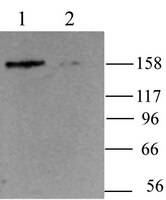AB5808-200UL Sigma-AldrichAnti-HCN4 Antibody
This Anti-HCN4 Antibody is validated for use in IH, WB for the detection of HCN4.
More>> This Anti-HCN4 Antibody is validated for use in IH, WB for the detection of HCN4. Less<<Recommended Products
Overview
| Replacement Information |
|---|
Key Spec Table
| Species Reactivity | Key Applications | Host | Format | Antibody Type |
|---|---|---|---|---|
| H, R, M | IHC, WB | Rb | Affinity Purified | Polyclonal Antibody |
| Description | |
|---|---|
| Catalogue Number | AB5808-200UL |
| Brand Family | Chemicon® |
| Trade Name |
|
| Description | Anti-HCN4 Antibody |
| Alternate Names |
|
| References |
|---|
| Product Information | |
|---|---|
| Format | Affinity Purified |
| HS Code | 3002 15 90 |
| Control |
|
| Presentation | Affinity purified immunoglobulin. Lyophilized from phosphate buffered saline, pH 7.4, containing 1% BSA, 0.05% sodium azide as a preservative. Reconstitute with 200 μL of sterile deionized water. Centrifuge antibody preparation before use (10,000 xg for 5 min). |
| Quality Level | MQ100 |
| Physicochemical Information |
|---|
| Dimensions |
|---|
| Materials Information |
|---|
| Toxicological Information |
|---|
| Safety Information according to GHS |
|---|
| Safety Information |
|---|
| Packaging Information | |
|---|---|
| Material Size | 200 µL |
| Transport Information |
|---|
| Supplemental Information |
|---|
| Specifications |
|---|
| Global Trade Item Number | |
|---|---|
| Catalogue Number | GTIN |
| AB5808-200UL | 04053252507878 |
Documentation
Anti-HCN4 Antibody SDS
| Title |
|---|
Anti-HCN4 Antibody Certificates of Analysis
References
| Reference overview | Application | Species | Pub Med ID |
|---|---|---|---|
| Targeted insertion of the Cre-recombinase gene at the phenylethanolamine n-methyltransferase locus: a new model for studying the developmental distribution of adrenergic cells Ebert, Steven N, et al. Dev Dyn, 231:849-858 (2004) 2004 | 15517585
 | ||
| Postnatal development of the hyperpolarization-activated excitatory current Ih in mouse hippocampal pyramidal neurons Vasilyev, Dmitry V and Barish, Michael E J. Neurosci., 22:8992-9004 (2002) 2002 | Immunofluorescence | Mouse | 12388606
 |















